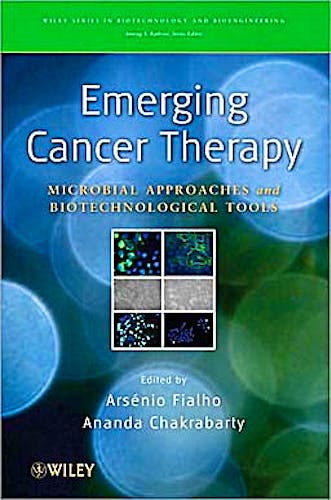

No hay productos en el carrito



Emerging Cancer Therapy: Microbial Approaches and Biotechnological Tools
Fialho, A. — Chakrabarty, A.
1ª Edición Julio 2010
Inglés
Tapa dura
432 pags
2000 gr
null x null x null cm
ISBN 9780470444672
Editorial WILEY
LIBRO IMPRESO
-5%
159,91 €151,91 €IVA incluido
153,76 €146,07 €IVA no incluido
Recíbelo en un plazo de
2 - 3 semanas
LIBRO ELECTRÓNICO
-5%
140,39 €133,37 €IVA incluido
134,99 €128,24 €IVA no incluido
Acceso On Line
Inmediato
Description
Explores current and emerging applications of microbes as cancer-fighting
agents
Today, treatment options for cancer patients typically include surgery, radiation
therapy, immunotherapy, and chemotherapy. While these therapies have saved lives
and reduced pain and suffering, cancer still takes millions of lives every year
around the world. In recent years, researchers have been working on a new strategy:
developing microbes and microbial products that specifically attack cancer cells.
This book breaks new ground in emerging cancer treatment modalities by presenting recent advances in the use of microorganisms and viruses as well as their products in cancer therapy. Seventeen chapters review the application of live microorganisms, high and low molecular weight products derived from microorganisms, and microbial products fused to cancer-targeting molecules. In addition, the book highlights the benefits of a multi-target approach to destroy cancer cells. Readers will not only discover the results and significance of basic and clinical research, but also encouraging results from clinical trials.
Emerging Cancer Therapy is divided into three sections:
Section 1: Live/Attenuated Bacteria and Viruses as Anticancer Agents
Section 2: Bacterial Products as Anticancer Agents
Section 3: Patents on Bacteria/Bacterial Products as Anticancer Agents
With chapters written by leading pioneers in microbial, biotech, and cancer research, Emerging Cancer Therapy is recommended for biotechnologists, microbiologists, clinical oncologists, medicinal chemists, and biochemists. Readers will not only learn the tremendous potential of microbial and biotechnological approaches to cancer therapy, but also discover new directions of research for effective drug discovery and development.
Table of Contents
PREFACE.
CONTRIBUTORS.
PART I LIVE/ATTENUATED BACTERIA AND VIRUSES AS ANTICANCER AGENTS.
1 Salmonella Typhimurium Mutants Selected to Grow Only in Tumors to Eradicate Them in Nude Mouse Models (Robert M. Hoffman).
2 The Use of Living Listeria Monocytogenes as an Active Immunotherapy for the Treatment of Cancer (John Rothman, Anu Wallecha, Paulo Cesar Maciag, Sandra Rivera, Vafa Shahabi, and Yvonne Paterson).
3 Bacillus Calmette–Guerin (BCG) for Urothelial Carcinoma of the Bladder (Timothy P. Kresowik and Thomas S. Griffith).
4 Live Clostridia: A Powerful Tool in Tumor Biotherapy (Lieve Van Mellaert, Ming Q Wei, and Jozef Anné).
5 Bifi dobacterium as a Delivery System of Functional Genes for Cancer Gene Therapy (Geng-Feng Fu, Yan Yin, Bi Hu, and Gen-Xing Xu).
6 Replication-Selective Viruses for the Treatment of Cancer (Padma Sampath and Steve H. Thorne).
7 Engineering Herpes Simplex Virus for Cancer Oncolytic Virotherapy (Jason S. Buhrman, Tooba A. Cheema, and Giulia Fulci).
PART II BACTERIAL PRODUCTS AS ANTICANCER AGENTS.
8 Promiscuous Anticancer Drugs from Pathogenic Bacteria: Rational Versus Intelligent Drug Design (Arsénio M. Fialho and Ananda M. Chakrabarty).
9 Arginine Deiminase and Cancer Therapy (Lynn Feun, M. Tien Kuo, Ming You, Chung Jing Wu, Medhi Wangpaichitr, and Niramol Savaraj).
10 Cytosine Deaminase/5-Fluorocytosine Molecular Cancer Chemotherapy (Sergey A. Kaliberov and Donald J. Buchsbaum).
11 Bacterial Proteins Against Metastasis (Anna Maria Elisabeth Walenkamp).
12 Pseudomonas Exotoxin A-Based Immunotoxins for Targeted Cancer Therapy (Philipp Wolf and Ursula Elsässer-Beile).
13 Denileukin Diftitox in Novel Cancer Therapy (Lin-Chi Chen and Nam H. Dang).
14 The Application of Cationic Antimicrobial Peptides in Cancer Treatment: Laboratory Investigations and Clinical Potential (Ashley L. Hilchie and David W. Hoskin).
15 Prodiginines and Their Potential Utility as Proapoptotic Anticancer Agents (Neil R. Williamson, Suresh Chawrai, Finian J. Leeper, and George P.C. Salmond).
16 Farnesyltransferase Inhibitors of Microbial Origins in Cancer Therapy (Jingxuan Pan and Sai-Ching Jim Yeung).
17 The Use of RNA and CpG DNA as Nucleic Acid-Based Therapeutics (Jörg Vollmer).
PART III PATENTS ON BACTERIA/BACTERIAL PRODUCTS AS ANTICANCER AGENTS.
18 The Role and Importance of Intellectual Property Generation and Protection in Drug Development (Arsénio M. Fialho and Ananda M. Chakrabarty).
INDEX.
Author Information
ARSÉNIO FIALHO, PhD, is Associate Professor in the Department of Chemical
and Biological Engineering and Principal Investigator for the Institute of Biotechnology
and Bioengineering in the Instituto Superior Técnico at the Universidade
Técnica de Lisboa, Portugal. His current scientific interests are focused
on the study of bacterial proteins, such as azurin and Laz, as novel multi-targeted
drug candidates with anticancer activities. He is the author or coauthor of
more than fifty papers in peer-reviewed scientific journals and, during the
last four years, became the holder of five U.S. patents. Dr. Fialho teaches
courses in biochemistry, molecular biology, and bioinformatics.
ANANDA CHAKRABARTY, PhD, is Distinguished University Professor in the Department
of Microbiology and Immunology at the University of Illinois College of Medicine
at Chicago. In addition to more than 250 research publications, he has secured
nine U.S. patents during the last four years on azurin and Laz, two bacterial
proteins with anticancer, anti-viral and anti-parasitic activities. He also
is the recipient of a patent on the first life form, a genetically manipulated
pseudomonad designed to degrade multiple hydrocarbons present in crude oil,
as decided by the U.S. Supreme Court in 1980 in the celebrated court case Diamond
v. Chakrabarty.
© 2025 Axón Librería S.L.
2.149.0